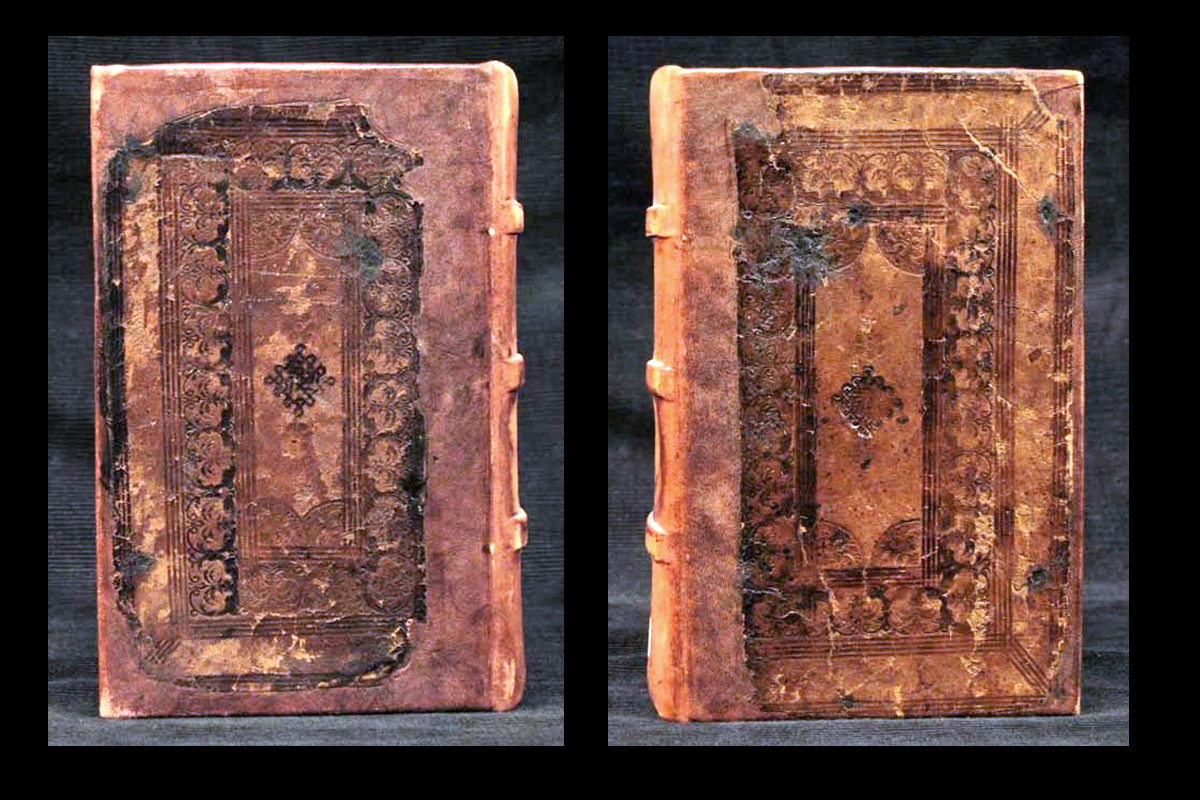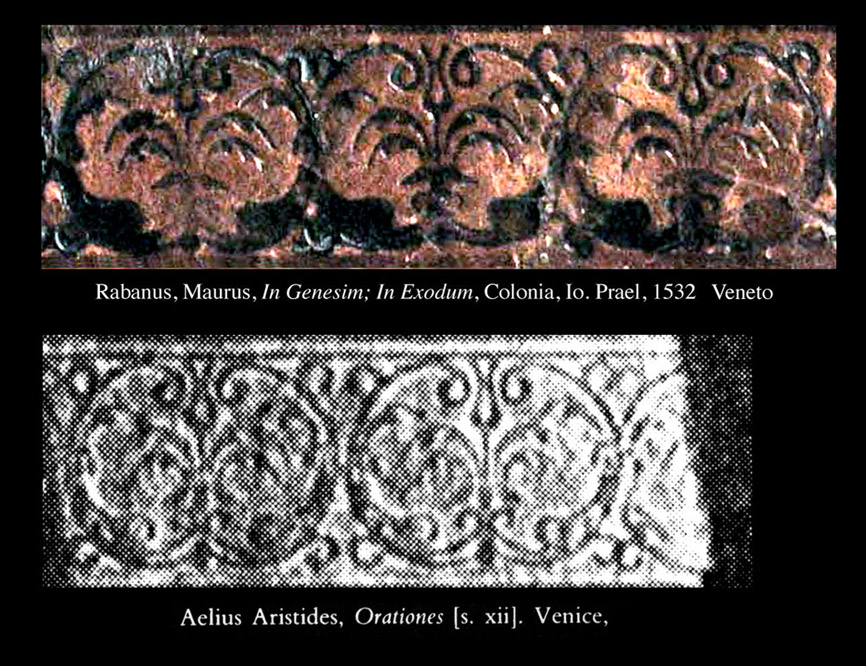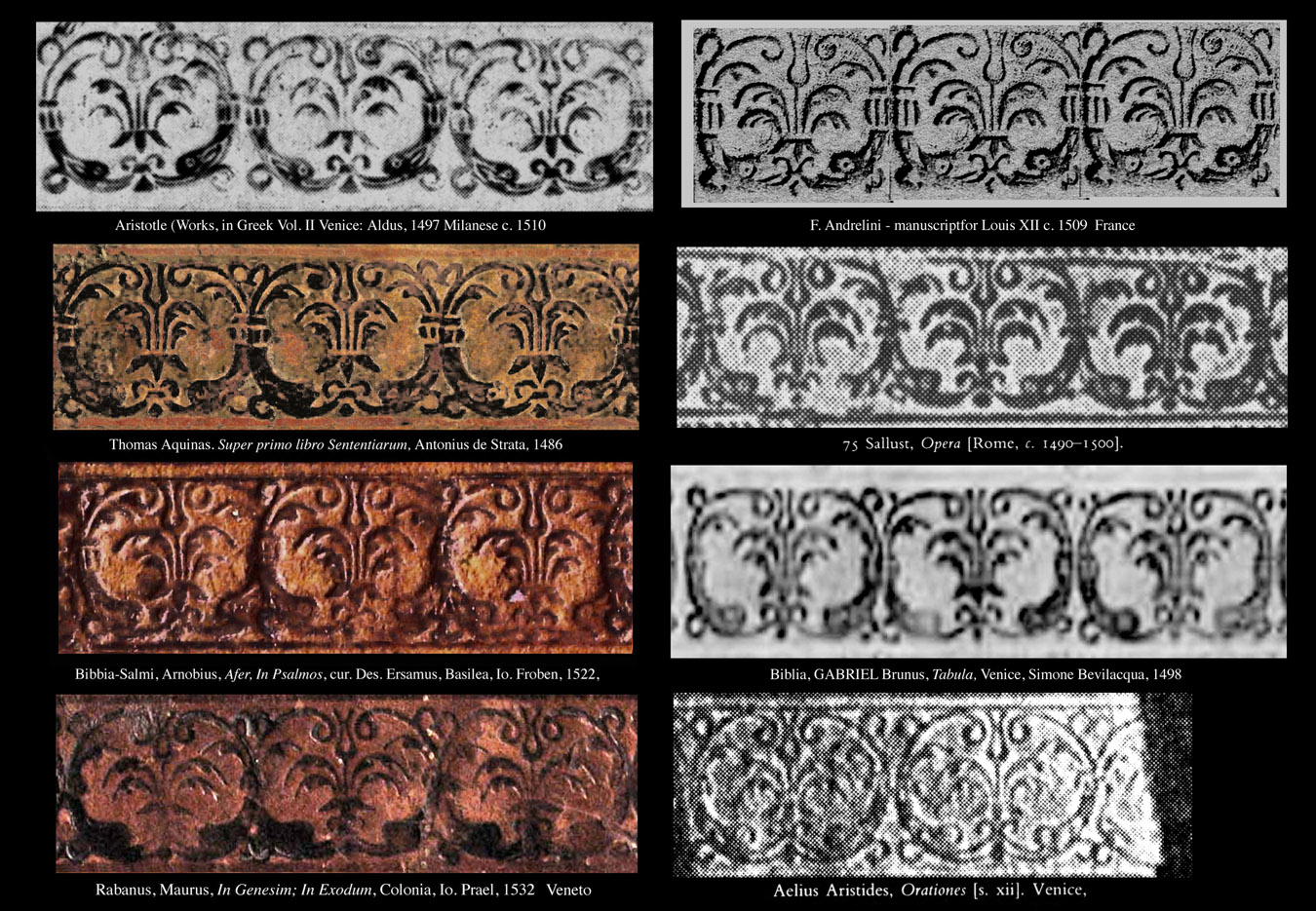

| I discovered this 1532 Venice binding with frame of diving dolphins at the web site of the Angelo Mai Public Library in Bergamo (Biblioteca Civica Angelo Mai). Within their description of bindings are often found enlargements of important details including clasps and individual motifs. This particular diving dolphin motif is found on the remnants a binding that could not have been made before 1532 based on the printing date of the book that it covers, and is therefore the most recent of all the examples found so far, most appear around 1510, while Anthony Hobson sites a 1476 example. In their notes about this binding which is shelfmarked as Cinquecenta 2 1, they state that the presence of the diving dolphin motif suggests a Venetian origin. |

| The interesting part of this story is that while I was making Comparative Diagram 2, a collection of the diving dolphins motifs. The last example that I added to the diagram was Hobson's rubbing from his 1989 book entitled Humanists and Bookbinders. It is the only rubbing in the diagram, and it just happened by chance that I placed it next to this 1532 example. I show both enlarged to 400 dpi in Comparative Diagram 1. Suddenly it dawned on me that the Hobson example closely matches the 1532 imprint, This imprint is unusual in that the dolphin's mouth is wide open and thus more distinct than most, also the fountain plumes are more extended and the lower plume has three lobes. A close inspection of Comparative Diagram 2 reveals just how different most other specimens can be, the two examples in Comparative Diagram 1 could quite possibly derive from the same tool! This possibility I found quite exciting and quickly searched Hobson's text for further information concerning the binding from which the rubbings were taken. |


| In relation to the diving dolphin motifs in his figure 54 rubbings, Anthony Hobson states: Two variants were owned by a Venetian stationer dealing with Greek manuscripts, whose clients included Fra Urbano Bolzani of Belluno, the author of the first Greek Grammar in the latin language. They can be seen on a twelfth-century Aristes in conjunction with two nondescript flowers and an Islamic interlaced centerpiece (fig. 54). Then there is a footnoot #31: |
| Venice, Bibl. Marciana, gr. VIII, 7 (= 1069): Mioni, II, 130-2. Other bindings from this same shop are Copenhagen, Royal Library, Gl. Kgl. Saml. 6 fol. (Kyster, no. 42; De Marinis, III, no. 2695ter, tav. B 2), 167 fol. and 1965 4to (all three bought by Frederik Roostgaard in Venice in 1699), Vat. gr. 281 and possibly Rheims, Bibl. municipale, Inc. 83 ( Ammonius Hermeae, In quinque voces Porphyrii, Venice 1500). The first and second belonged to Fra Urbano; the first had been given him by Marcus Musurus (Mioni, 'Marco Musuro', 16) |
|
In Wikipedia we find: Urbano Dalle Fosse meglio noto come Urbano Bolzanio (Belluno, 1442-Venezia, aprile 1524) ...fu collaboratore di Aldo Manuzio (Aldus Manutius) per i cui tipi pubblico nel 1498 una grammatica greca. and Marcus Musurus, Markos Mousouros; Italian: Marco Musuro; c. 1470-1517) was a Greek scholar and philosopher born in Retimo, Castello, Venetian Crete (modern Rethymno, Crete). The son of a rich merchant, he became at an early age a pupil of John Lascaris in Venice. In 1505, Musurus was made professor of Greek language at the University of Padua. Erasmus, who had attended his lectures there, testifies to his knowledge of Latin. However, when the university was closed in 1509 during the War of the League of Cambrai, he returned to Venice where he filled a similar post. In 1516, Musurus was summoned to Rome by Pope Leo X, where he lectured in the pope's Gymnasium and established a Greek printing-press. In recognition of a Greek poem prefixed to the editio princeps of Plato, Leo appointed him archbishop of Monemvasia (Malvasia) in the Peloponnese, but he died before he left the Italian peninsula. From 1493, Musurus was associated with the famous printer Aldus Manutius and belonged to the Neacademia (Aldine Academy of Hellenists), a society founded by Manutius and other learned men for the promotion of Greek studies. Many of the Aldine classics were published under Musurus' supervision, and he is credited with the first editions of the scholia of Aristophanes (1498), Athenaeus (1514), Hesychius of Alexandria (1514) and Pausanias (1516). Musuros' handwriting reportedly formed the model of Aldus' Greek type. Among his original compositions Musurus wrote a dedicatory epigram for Zacharias Kallierges' edition of the Etymologicum Magnum,[1] in which he praised the genius of the Cretans. Musurus died in Rome. From these facts we know that both of these men worked for Aldus Manutius and in 1498 both were perhaps colaborating on the Aristophanes and Grammatica greca publications. Considering the date of the third binding mentioned by Hobson , Inc. 83 ( Ammonius Hermeae, In quinque voces Porphyrii, Venice 1500). We might easily imagine that the fig. 54 imprints date from around this time and anyway they can be no later than 1517, this still leaves a gap of 15 years. |
| about the author | VIRTUAL BOOKBINDING |